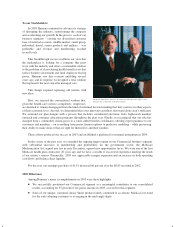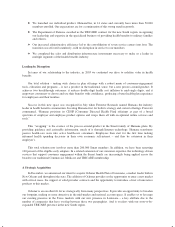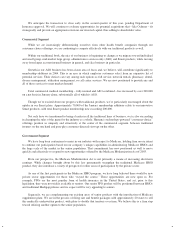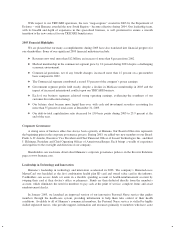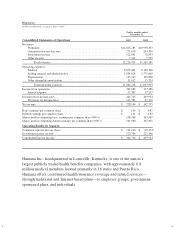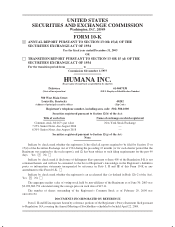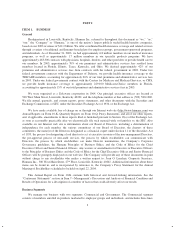Humana 2003 Annual Report Download - page 13
Download and view the complete annual report
Please find page 13 of the 2003 Humana annual report below. You can navigate through the pages in the report by either clicking on the pages listed below, or by using the keyword search tool below to find specific information within the annual report.
Our Products Marketed to Commercial Segment Employers and Members
New Generation of Products
We have developed a range of innovative products, styled as “Smart” products, that we believe will be a
solution for employers who annually are facing double-digit premium increases driven by medical cost inflation.
Our new generation of products provide more (1), choices for the individual consumer, (2), transparency of
provider costs, and (3), benefit designs that engage consumers in the costs and effectiveness of health care
choices. Innovative tools and technology are available to assist consumers with these decisions, including the
trade-offs between higher premiums and point-of-service costs at the time consumers choose their plans, and to
suggest ways in which the consumers can maximize their individual benefits at the point they use their plans.
These products are sold to employers with Humana as the sole carrier, but are available on either a fully insured
or self-funded basis. As of December 31, 2003, we had enrolled approximately 130,000 members into our Smart
products.
Many of our Smart products, as well as our more traditional products, are offered to employer groups as
“bundles”, where the subscribers are offered various HMO and PPO options, with various employer contribution
strategies as determined by the customer.
HMO
Our health maintenance organization, or HMO, products provide prepaid health insurance coverage to our
members through a network of independent primary care physicians, specialty physicians, and other health care
providers who contract with the HMO to furnish such services. Primary care physicians generally include
internists, family practitioners, and pediatricians. Generally, the member’s primary care physician must approve
access to certain specialty physicians and other health care providers. These other health care providers include,
among others, hospitals, nursing homes, home health agencies, pharmacies, mental health and substance abuse
centers, diagnostic centers, optometrists, outpatient surgery centers, dentists, urgent care centers, and durable
medical equipment suppliers. Because the primary care physician generally must approve access to many of
these other health care providers, the HMO product is considered the most restrictive form of managed care.
An HMO member, typically through the member’s employer, pays a monthly fee, which generally covers,
with some copayments, health care services received from or approved by the member’s primary care physician.
For the year ended December 31, 2003, commercial HMO premium revenues totaled approximately $2.9 billion,
or 23.7% of our total premiums and ASO fees.
PPO
Our preferred provider organization, or PPO, products, which are marketed primarily to commercial groups
and individuals, include some elements of managed health care. However, they typically include more cost-
sharing with the member, through copayments and annual deductibles. PPOs also are similar to traditional health
insurance because they provide a member with more freedom to choose a physician or other health care provider.
In a PPO, the member is encouraged, through financial incentives, to use participating health care providers,
which have contracted with the PPO to provide services at favorable rates. In the event a member chooses not to
use a participating health care provider, the member may be required to pay a greater portion of the provider’s
fees.
In June 2002, we introduced HumanaOne, a major medical product marketed directly to individuals. We
introduced this product in select markets where we can utilize our existing networks and distribution channels.
For the year ended December 31, 2003, commercial and individual PPO premium revenues totaled
approximately $3.4 billion, or 27.9% of our total premiums and ASO fees.
5


